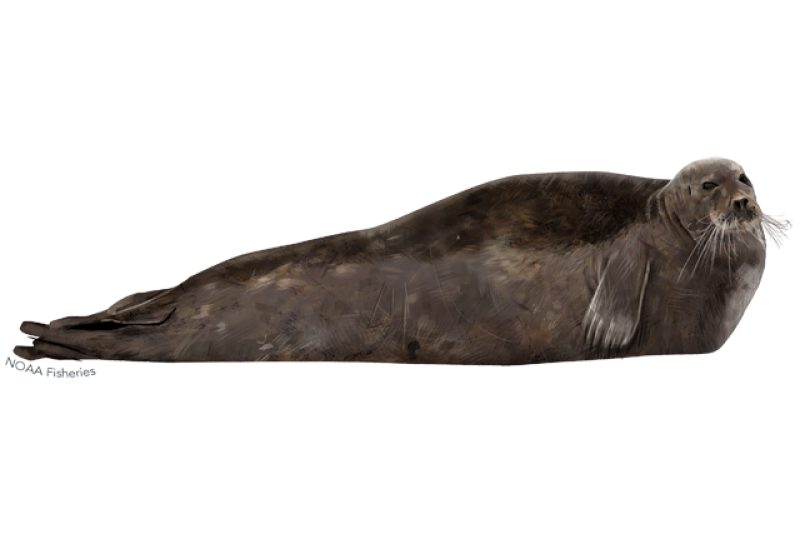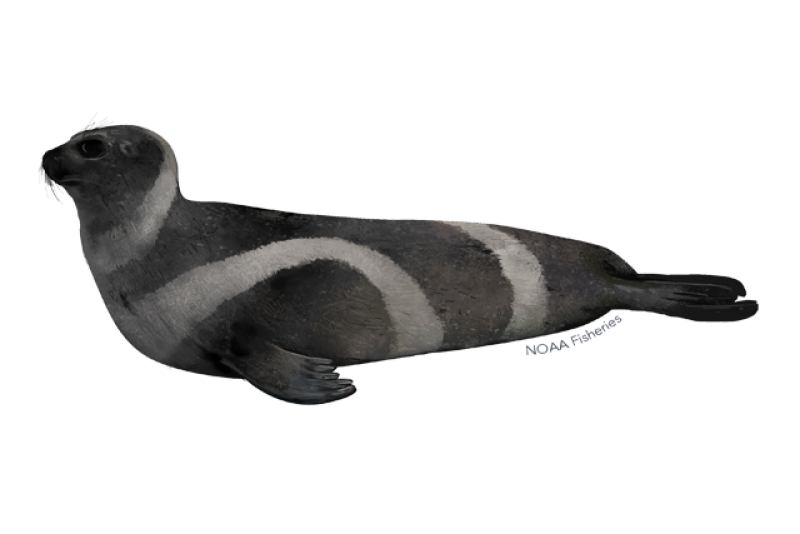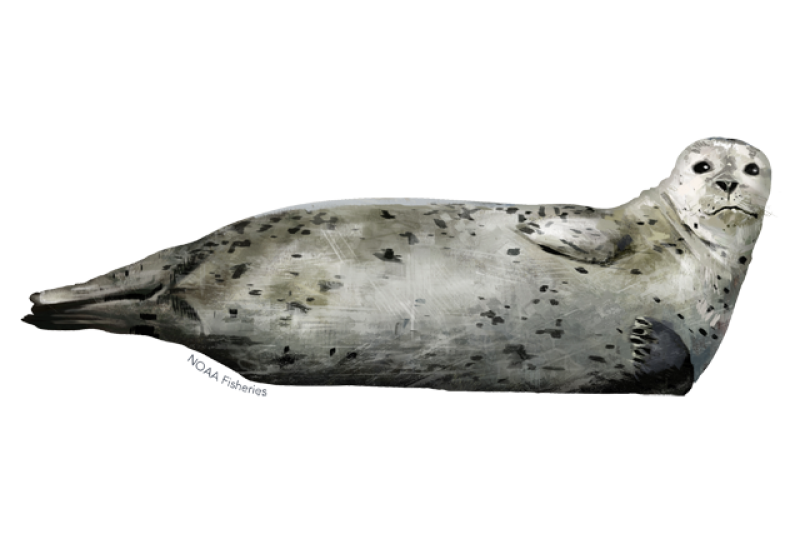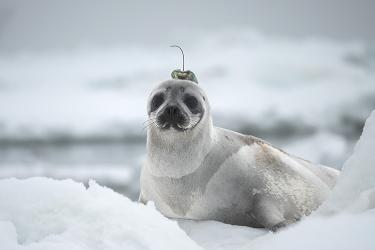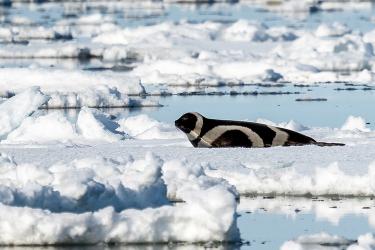Spotted Seal
Phoca largha

Protected Status
Quick Facts
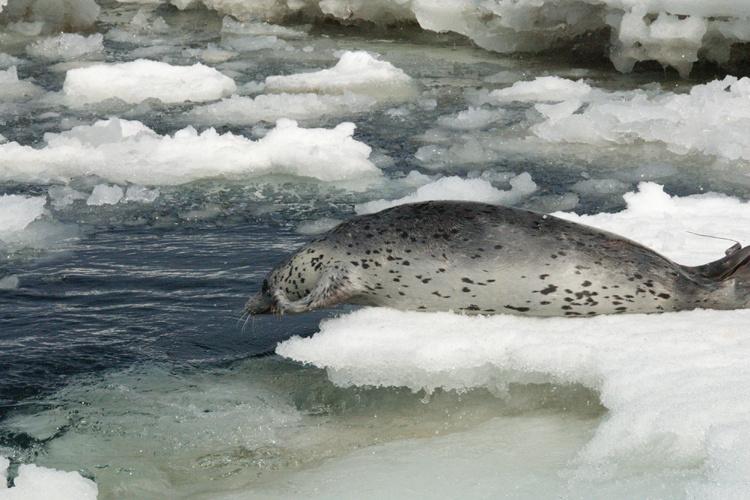 Spotted seal release - Photo: Dave Withrow
Spotted seal release - Photo: Dave Withrow
Spotted seal release - Photo: Dave Withrow
About the Species
 Spotted seal release - Photo: Dave Withrow
Spotted seal release - Photo: Dave Withrow
Spotted seal release - Photo: Dave Withrow
The spotted seal gets its name from its coat pattern, which is usually a light-colored background with dark spots. Spotted seals are widely distributed on the continental shelf of the Beaufort, Chukchi, southeastern East Siberian, Bering, and Okhotsk Seas; south through the Sea of Japan; and into the northern Yellow Sea. From late fall through spring, spotted seal habitat use is primarily associated with seasonal sea ice. Most spotted seals spend the rest of the year making periodic foraging trips from haul-out sites onshore or on sea ice. Spotted seals are unusual among true seals in that they annually form "family" groups or “triads” consisting of a female, a male, and a pup during breeding season.
Spotted seals rely on sea ice during whelping, breeding, and molting seasons. As such, they are sensitive to changes in the environment that affect the annual timing and extent of sea ice formation and breakup.
Spotted seals, like all marine mammals, are protected under the Marine Mammal Protection Act. There is one recognized stock of spotted seals in U.S. waters: the Bering stock. One distinct population segment of spotted seals outside U.S. waters (the southern distinct population segment, DPS)—with breeding concentrations in the Yellow Sea and the Sea of Japan—is listed as threatened under the Endangered Species Act. Because of its listed status, this DPS is also designated as depleted under the MMPA.
Population Status
No accurate range-wide abundance estimates exist for spotted seals. Based on crude estimates available in historic literature, the worldwide population of spotted seals is estimated to be more than 500,000 individuals.
There is one recognized stock of spotted seals in U.S. waters: the Bering stock. Abundance estimates for this stock are provided in the stock assessment report.
Historically, subsistence harvest of spotted seals has been moderately low and is not anticipated to increase significantly. While the United States does not allow the commercial harvest of marine mammals, such harvests are permitted in some other portions of the species’ range. Based on available data, these harvests are not thought to have been high enough historically to cause significant reductions in abundance and appear to be generally limited.
Appearance
Spotted seals have a round head, narrow snout, and small body, as well as narrow, short flippers. Adult spotted seals are silvery-gray to light gray with dark spots scattered densely on their body. Pups are born with a white natal coat (lanugo) that is usually shed at the time of weaning and replaced with a coat that is similar to adults. Spotted seals grow to average lengths of 5 feet, with weights ranging from 140 to 250 pounds. Males and females are generally similar in appearance. Spotted seals are closely related and often confused with harbor seals in areas where you can find both, such as in Bristol Bay, Alaska.
Behavior and Diet
Spotted seals prefer arctic or sub-arctic waters and are often found within the outer margins of shifting ice floes. They rarely inhabit areas of dense pack ice. In the spring, during the breeding and molting seasons, spotted seals primarily haul out on ice floes, whereas during the summer months they can be found in the open ocean or hauled out on shore.
Spotted seals consume a broad variety of mostly fishes and some crustaceans and cephalopods. While regional differences in the diet of spotted seals are noted among studies, some prey items are important across almost the entire range of the species. Pacific herring and crustaceans are major prey in all locations except the central Bering Sea, and walleye pollock is important in all regions except the Chukchi Sea. Spotted seals are not deep divers and feed almost exclusively over the continental shelf in waters less than 650 feet deep.
Where They Live
Spotted seals live in the waters of the North Pacific Ocean and adjacent southern parts of the Arctic Ocean. They are widely distributed on the continental shelf of the Beaufort, Chukchi, southeastern East Siberian, Bering, and Okhotsk Seas; south through the Sea of Japan; and into the Yellow Sea.
In U.S. waters, spotted seals migrate south from the Beaufort and Chukchi Seas through the Bering Strait from October to November with the advancing sea ice. They spend the winter in the Bering Sea in the annual pack ice over the continental shelf. During spring and summer, they migrate to coastal habitats after the sea ice retreats.
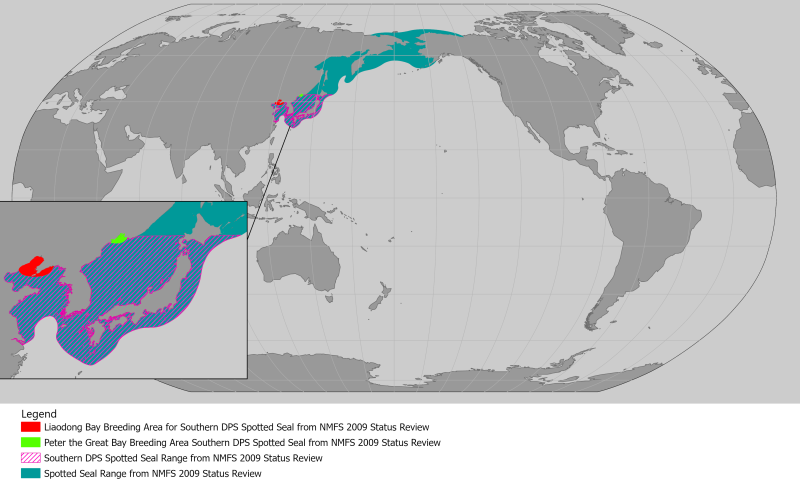 World map providing approximate representation of the Spotted seal's range
World map providing approximate representation of the Spotted seal's range
Lifespan & Reproduction
Nearly all spotted seals reach sexual maturity by the time they are 5 years of age. Spotted seal pups are born anytime from January through April, depending on their location. The pupping and nursing season occurs earliest (January through early March) in the Yellow Sea and latest (late March through May) in the northern Sea of Okhotsk and Bering Sea, with a peak of pup births in the northern Sea of Okhotsk and Bering Sea in early to mid-April. Females mate shortly after their pups are weaned. Males are thought to be annually monogamous, and spotted seals form "family" groups consisting of a female, male, and a pup during breeding season. Gestation lasts for just over 10 months. Their maximum lifespan is 30 to 35 years.
Pups are born with a white natal coat (lanugo), which is shed around the time of weaning, and weigh 15 to 26 pounds at birth. They are nursed for 3 to 6 weeks, during which time they may more than triple their birth weight. Pups born on the sea ice only occasionally enter the water before they are weaned and molted. During the first few weeks after weaning, pups remain at least partially dependent on ice while they become proficient at diving and foraging for themselves.
Threats
Climate Change
Spotted seals are primarily associated with sea ice during reproduction and molting. As such, spotted seals are sensitive to changes in the environment that affect the timing and extent of sea ice formation and breakup. In particular, loss of sea ice habitat poses a significant threat to the Southern distinct population segment (DPS) of spotted seals, which breeds in the Yellow Sea and Peter the Great Bay in the Sea of Japan.
Additional Factors of Potential Concern
The continuing decline in summer sea ice in recent years has renewed interest in using the Arctic Ocean as a potential waterway for coastal, regional, and trans-Arctic marine operations, which pose varying levels of threat to spotted seals depending on the type and intensity of the shipping activity and its degree of spatial and temporal overlap with the seals. Offshore oil and gas exploration and development could also impact spotted seals. The most significant risk posed by these activities is accidentally or illegally discharging oil or other toxic substances, which would have immediate and potentially long-term effects. Spotted seals could also be directly affected by noise and physical disturbance of habitat associated with such activities.
Scientific Classification
| Kingdom | Animalia | Phylum | Chordata | Class | Mammalia | Order | Carnivora | Family | Phocidae | Genus | Phoca | Species | largha |
|---|
Last updated by NOAA Fisheries on 04/08/2025
What We Do
Conservation & Management
NOAA Fisheries is committed to the protection and recovery of spotted seals. In the United States, management actions taken to secure protections for these seals include:
- Overseeing marine mammal health and stranding response.
- Reducing interactions with fishing gear.
- Working cooperatively under our co-management agreements with Alaska Native organizations, particularly the Ice Seal Committee, regarding issues related to subsistence use of ice seals, including spotted seals.
- Educating the public about spotted seals and the threats they face.
Science
Our research projects have discovered new aspects of spotted seal biology, behavior, and ecology and helped us better understand the challenges that all spotted seals face. Our work includes:
- Conducting abundance and distribution surveys.
- Using satellite telemetry to track movements, foraging, and haul-out behavior.
- Sampling tissue to evaluate population structure and health.
- Collecting feces to investigate diet.
How You Can Help
Report Marine Life in Distress
In Alaska, report a sick, injured, entangled, stranded, or dead marine mammal to the Alaska Marine Mammal Stranding Hotline at (877) 925-7773 to make sure professional responders and scientists know about it and can take appropriate action. Numerous organizations around Alaska are trained to receive reports and respond when necessary.
On the west coast of the U.S., please contact the West Coast Region Stranding Hotline at (866) 767-6114.
Other reporting hotlines and resources:
- To report entangled marine mammals:
- Entanglement Reporting Hotline: 1-877-SOS-WHAL or 1-877-767-9425
- The U.S. Coast Guard: VHF Ch. 16
- To report derelict gear:
- Derelict Gear Hotline: 1-855-542-3935
- Regional stranding response contacts
Keep Your Distance
Be responsible when viewing marine life in the wild. Observe all seals and sea lions from a safe distance of at least 50 yards and limit your time spent observing to 30 minutes or less.
Report a Violation
Call the NOAA Fisheries Enforcement Hotline at (800) 853-1964 to report a federal marine resource violation. This hotline is available 24 hours a day, 7 days a week for anyone in the United States.
You may also contact your closest NOAA Office of Law Enforcement field office during regular business hours.
Featured News
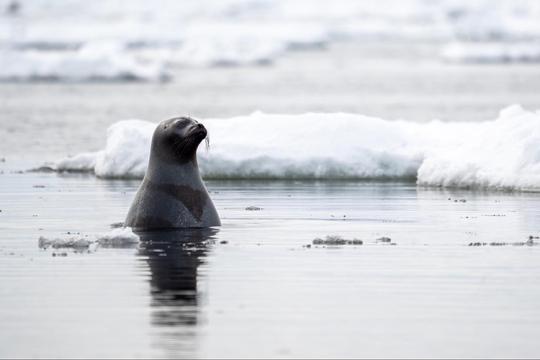 An adult female ribbon seal looks around among ice floes in the Bering Sea. Animals are much harder to detect during aerial surveys when they are in the water. Credit: NOAA Fisheries / Josh M London / Photo taken under authority of NOAA Fisheries Research Permit #23858.
An adult female ribbon seal looks around among ice floes in the Bering Sea. Animals are much harder to detect during aerial surveys when they are in the water. Credit: NOAA Fisheries / Josh M London / Photo taken under authority of NOAA Fisheries Research Permit #23858.
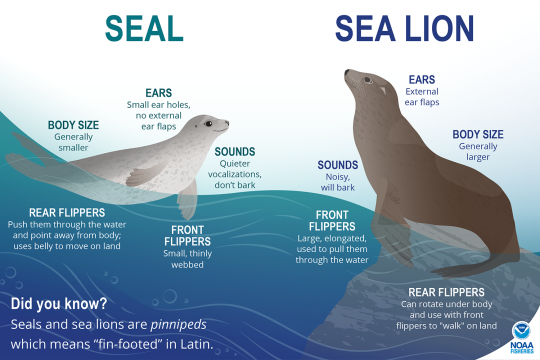 At first glance, seals (true or “earless seals”) and sea lions look fairly similar. Taking a closer look, these are some of the general differences to tell these animals, such as on the harbor seal (left) and California sea lion (right) pictured above.
At first glance, seals (true or “earless seals”) and sea lions look fairly similar. Taking a closer look, these are some of the general differences to tell these animals, such as on the harbor seal (left) and California sea lion (right) pictured above.
Is It a Seal or a Sea Lion?
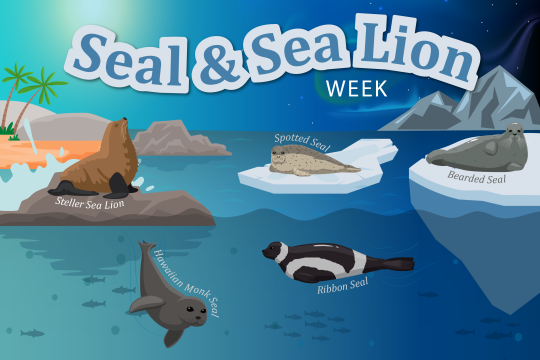 Seal & Sea Lion Week is March 11-15, 2024.
Seal & Sea Lion Week is March 11-15, 2024.
Seal and Sea Lion Week
Management Overview
The spotted seal Southern distinct population segment (DPS) is listed as threatened under the Endangered Species Act.
The spotted seal is protected throughout its range under the Marine Mammal Protection Act.
The Southern DPS is depleted under the Marine Mammal Protection Act.
Co-Management Agreements
Alaska Natives have a long history of subsistence use of marine mammals for food and handicrafts.
In 1994, the MMPA was amended to add section 119, which reads, "The Secretary may enter into cooperative agreements with Alaska Native Organizations to conserve marine mammals and provide co-management of subsistence use by Alaska Natives." These co-management agreements may be established between NOAA Fisheries or the U.S. Fish and Wildlife Service and Alaska Native Organizations, including (but not limited to) Alaska Native tribes and tribally authorized co-management bodies. Co-management promotes full and equal participation by Alaska Natives in decisions affecting the subsistence management of marine mammals (to the maximum extent allowed by law) as a tool for conserving marine mammal populations in U.S. waters in and around Alaska.
NOAA Fisheries entered into a co-management agreement with the Ice Seal Committee (PDF, 7 pages) in October 2006. The Ice Seal Committee is an Alaska Native Organization that represents ice seal subsistence users in the five regions of Alaska that harvest ice seals: Bristol Bay (Bristol Bay Native Association), Yukon-Kuskokwim Delta (Association of Village Council Presidents), Bering Sea (Kawerak, Inc.), Northwest Arctic (Maniilaq Association), and the Arctic Slope (North Slope Borough). The Ice Seal Committee is dedicated to conserving ice seal populations, habitat, and hunting and to preserving native cultures and traditions. The Ice Seal Committee co-manages ice seals with NOAA Fisheries by monitoring subsistence harvest and cooperating on needed research, and education programs pertaining to ice seals.
The Ice Seal Committee adopted an Ice Seal Management Plan (PDF, 8 pages) in January 2012 that outlines the members' management principles and goals.
Learn more about the Ice Seal Committee
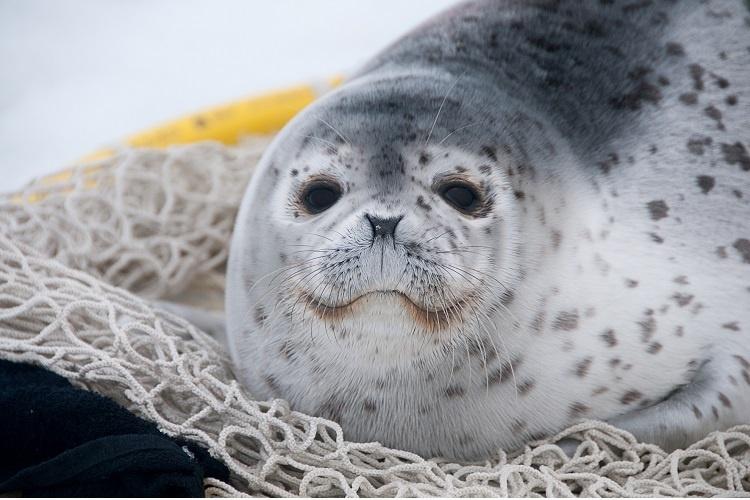
Conservation Efforts
Overseeing Marine Mammal Health and Stranding Response
We work with volunteer networks in all coastal states to respond to marine mammal strandings including all pinnipeds. When stranded animals are found alive, NOAA Fisheries and our partners assess the animal’s health and determine the best course of action. When stranded animals are found dead, our scientists work to understand and investigate the cause of death. Although the cause often remains unknown, scientists can sometimes attribute strandings to disease, harmful algal blooms, vessel strikes, fishing gear entanglements, pollution exposure, and underwater noise. Some strandings can serve as indicators of ocean health, giving insight into larger environmental issues that may also have implications for human health and welfare.
Learn more about the Marine Mammal Health and Stranding Response Program
Marine Mammal Unusual Mortality Events
Spotted seals have experienced unusual mortality events (UMEs) in the past. Under the Marine Mammal Protection Act, an UME is defined as "a stranding that is unexpected; involves a significant die-off of any marine mammal population; and demands immediate response." To understand the health of marine mammal populations, scientists study UMEs.
Get information on active and past UMEs
Regulatory History
Spotted seals, like all marine mammals, are protected under the MMPA.
Key Actions and Documents
Incidental Take Authorization: U.S. Army Corps of Engineers' Port of Nome Modification Project in Nome, Alaska
Incidental Take Authorization: University of Alaska Geophysics Institute Geophysical Surveys in the Arctic Ocean
Incidental Take Authorization: Lamont-Doherty Earth Observatory Marine Geophysical Survey in the Aleutian Islands
Incidental Take Authorization: Alaska Gasline Development Corporation Liquefied Natural Gas (LNG) Construction in Prudhoe Bay, Alaska
Last updated by NOAA Fisheries on 04/08/2025
Science Overview
NOAA Fisheries conducts a variety of research on the biology, behavior, and ecology of spotted seals. The results of this research are used to inform management decisions and enhance protection efforts for this species.
Population/Stock Assessments
Our scientists collect information on spotted seals from various sources and present these data in an annual stock assessment report. Stock assessment reports contain scientific information on a species’ or stock’s geographic range, population structure, abundance, and threats, which helps resource managers assess the success of enacted management and conservation measures.
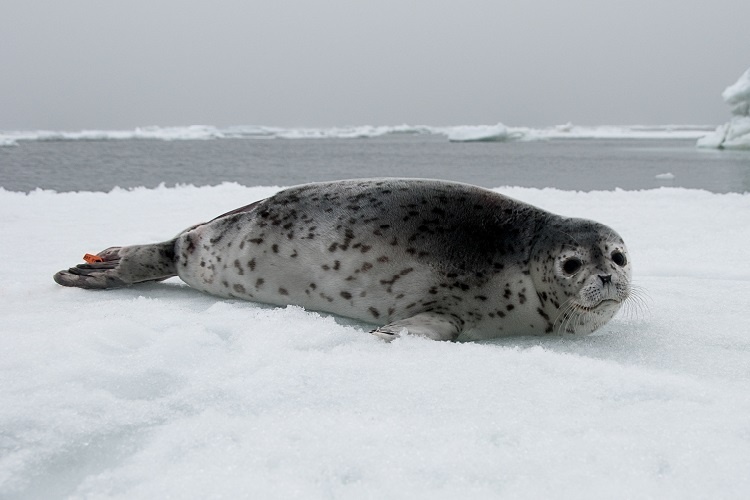
A tagged spotted seal sits on the ice. Photo: NOAA Alaska Fisheries Science Center/Dave Withrow.
Ice Seal Surveys
Reliable distribution and abundance estimates for ice-associated seals are vital for developing sound plans for management, conservation, and responses to potential environmental impacts. NOAA Fisheries’ Marine Mammal Laboratory Polar Ecosystems Program designs and conducts surveys and uses the results to develop data products to address this fundamental information need. Additional information about the program’s research is available in recent reports and publications.
Genetic Analysis
Molecular genetic techniques are being applied to a number of taxonomic, evolutionary and demographic questions in all ribbon, ringed, spotted, and bearded seals, including the relationships among the different species and the population structure and dispersal patterns within each species.
NOAA’s Southwest Fisheries Science Center and the Alaska Department of Fish and Game are currently involved in a long-term study of the population structure within spotted seals and the evolutionary and contemporary relationship of this species to the morphologically similar harbor seal. Differences in mitochondrial DNA confirmed that these two seals were indeed separate species. More recent research has detected population structure in spotted seals only over very large (>620 miles) distances and has documented several individuals that, although identified as harbor seals in the field, turned out to have the spotted seal genetic signature.
Additional Research
The Polar Ecosystems Program’s ongoing research on abundance, distribution, migration, foraging behavior, and health of spotted seals in Alaska helps us to understand the role of spotted seals in the marine ecosystem and inform management decisions for the conservation of this species.
Last updated by NOAA Fisheries on 04/08/2025
Documents
Ice Seal Management Plan (2012)
Principles by which the members of the Ice Seal Committee will manage ice seals.
Biological and Conference Opinion on the Issuance of Marine Mammal Protection Act Permit No. 20466 to Alaska Department of Fish and Game for Scientific Research on Ice Seals
This document represents the NOAA Fisheries opinion on the effects of these actions on the bearded…
Summary of Peer Reviewer Comments and Biological Review Team Responses for the Status Review of the Spotted Seal
Comments received on the Status Review of the Spotted.
Status Review of the Spotted Seal (Phoca largha)
NOAA Technical Memorandum NMFS-AFSC-200. Status Review of the Spotted Seal (Phoca largha) to…
Data & Maps
Alaska Spotted Seal Data Sets
The Alaska Fisheries Science Center's spotted seal data sets are available on the NOAA Fisheries…
Alaska Ice Seal Data Sets
The Alaska Fisheries Science Center's ice seal (bearded, ringed, spotted and ribbon seals) data…
Ice Seal Distribution Data of Alaska
Separate Biological Review Teams (BRTs) were convened by NOAA Fisheries to assess the best…
Research
Alaska Marine Mammal Field Work
NOAA Fisheries Alaska Fisheries Science Center and National Oceanic & Atmospheric Administration conduct research on marine mammals off the coasts of Alaska, Washington, Oregon, and California.
Outreach & Education
2024 Alaska Marine Mammal Field Work Flyer
The Alaska Fisheries Science Center (AFSC) of NOAA Fisheries, National Oceanic & Atmospheric…
2023 Alaska Marine Mammal Field Work Flyer
The Alaska Fisheries Science Center (AFSC) of NOAA Fisheries, National Oceanic & Atmospheric…
2022 Alaska Marine Mammal Field Work Flyer
The Alaska Fisheries Science Center (AFSC) of NOAA Fisheries, National Oceanic & Atmospheric…
2021 Alaska Marine Mammal Field Work Flyer
The Alaska Fisheries Science Center (AFSC) of NOAA Fisheries, National Oceanic & Atmospheric…
Last updated by NOAA Fisheries on 04/08/2025

